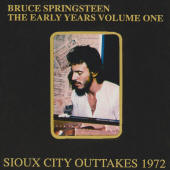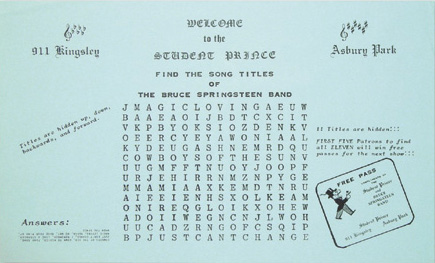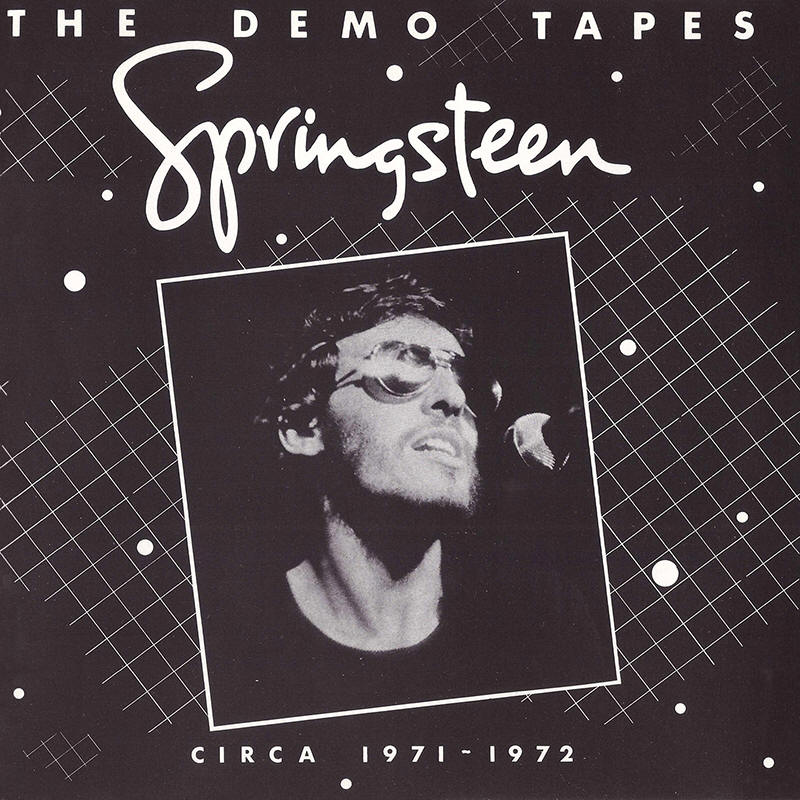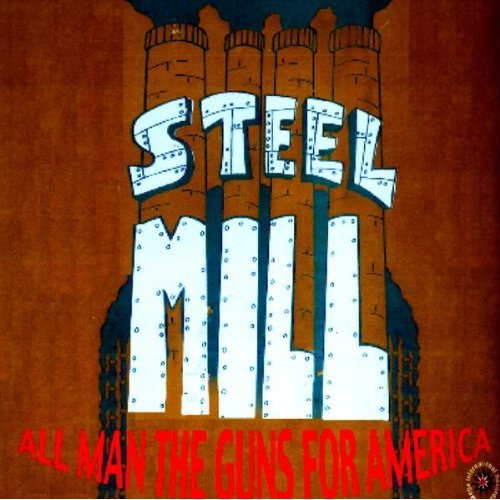COWBOYS OF THE SEA 
Studio version #1
They ride beneath the waves at twenty-thousand leagues
On stallions stitched to seaweed strands, so smiling, so smiling
They herd the fishes of the deep, they ride for you and me
They ranch the rich and the sunken soil at the bottom of the sea
And in the dead of night, alive in sleep I hear them calling me
Them deep sea desperadoes, the midnight maelstrom freaks, the cowboys of the sea
On wings of sleep I pierce the deep and ride like a hurricane
At midnight still I paid my bill and I turned my back on the land
With the help of Old Paint, that seaweed nag, it's just Jesse James and me
We ride the depths and rob the banks at the bottom of the sea
Oh, and with a seaman's grip on navigation and some fired, hired hands
We ride out to confront the nation and lend a cowboy's hand
We do the dolphins dance duet, my mermaid babe and me
Then I ride off into the blue sunset at the bottom of the sea
And with the seaman's grip on submarining and some aqualung outlaws
Our guns are made of solid dreaming and bullets from a broken cause
Oh, and with hand held high to touch the sky a good Texas Ranger I'll be
But sometimes I feel like a lone stranger 'midst the cowboys of the sea
Oh, and man above he cannot make love, he must rape his mother the sea
And because of his greed we're a vanishing breed, we cowboys of the sea
Ooh ooh ooh
Info
COWBOYS OF THE SEA is a song written by Bruce Springsteen who recorded it in studio in mid-1972. See the "London Publishing Demos" section below. The song, which has been performed live around that period, has not been officially released. The above lyrics are transcribed from a studio take of the song recorded in May or June 1972.
Decades later, COWBOYS OF THE SEA was recorded by Jersey Shore band Steel Mill Retro who released it on All Man The Guns For America, their 2008 album of Bruce Springsteen songs that were first performed by the original Steel Mill. See Steel Mill Retro's cover version for more details.
Writing and Recording
COWBOYS OF THE SEA was written in 1971; it appears on a 1971 table mat puzzle produced by the Student Prince club.
The Bruce Springsteen Band performed frequently at Student Prince in Asbury Park, NJ, between mid-November and mid-December 1971. A table mat puzzle was produced by the club for use during this month-long residency. The goal is to find the eleven hidden Bruce Springsteen Band song titles, and the first five patrons to find all of them would win free passes for the next show at the club. The eleven song titles are: COWBOYS OF THE SEA, DOWN TO MEXICO, FUNK SONG, I REMEMBER, I JUST CAN'T CHANGE, LIKE A STRANGER, MAGIC LOVING, MAKE YOUR MIND UP, MARIA, NO WAY, and WHEN YOU DANCE. These songs range from Steel Mill-era creations to recently written material. Two of them however, MARIA and NO WAY, are not known from any circulating audio.
Student Prince song titles puzzle
Two studio versions of COWBOYS OF THE SEA are in circulation among collectors. The first one is a studio take likely recorded around May-Jun 1972 at Pocketful Of Tunes Studios in New York City, NY. It features Springsteen solo on vocals and acoustic guitar. The May-Jun 1972 sessions at Pocketful Of Tunes Studios were produced by Mike Appel and Jim Cretecos, and Cretecos took the role of recording engineer. The second one (see studio version #2) is a studio take likely recorded around Jul-Aug 1972 at 914 Sound Studios in Blauvelt, NY. It features Springsteen solo on vocals and acoustic guitar. The Jul-Aug 1972 sessions at 914 Sound Studios were produced by Mike Appel and Jim Cretecos, and Louis Lahav took the role of recording engineer. The above lyrics transcribed from the first (May-Jun 1972) studio version of COWBOYS OF THE SEA.
Bruce Springsteen performed COWBOYS OF THE SEA during an audition for Mike Appel and Jim Cretecos on 14 Feb 1972 at Appel's office at Pocketful Of Tunes. Bob Spitz was also present and he recorded the performance on a reel-to-reel tape recorder. A solo demo of COWBOYS OF THE SEA was performed and recorded during Springsteen's first formal studio audition for CBS Records on 03 May 1972. It feature Springsteen solo on vocals and acoustic guitar. See the 03 May 1972 demo version and the "1971-1972 Auditions" section below for more details.
1971-1972 Auditions
On 04 Nov 1971, Carl "Tinker" West, then-manager of The Bruce Springsteen Band, drove Bruce Springsteen to New York City to introduce him to Mike Appel, a songwriter who carried on his songwriting activities jointly with Jim Cretecos. Appel was then employed at Pocketful Of Tunes Inc., Wes Farrell's publishing company in New York City, NY, and the meeting took place at Pocketful Of Tunes. Springsteen performed two or three songs, some on piano and some on acoustic guitar. Only Appel and West were present at this first meeting. Appel has stated in interview that he was not particularly impressed by what he heard at this initial audition but did see raw creativity in the lyrics of BABY DOLL. That performance was not recorded and the titles of the other song(s) performed remain unclear. Appel indicated an interest in promoting them in some way and the meeting ended with an agreement to keep in touch but no commitments from either party.
Meanwhile Springsteen continued gigging with The Bruce Springsteen Band in New Jersey and Virginia and visited his family in California for a few weeks around the holidays. The next meeting between Springsteen and Appel took place on 14 Feb 1972. Springsteen performed a set of seven songs at Appel's office at Pocketful Of Tunes. The songs were performed live solo on acoustic guitar to an audience of three: Mike Appel, Jim Cretecos, and Bob Spitz. Spitz recorded the performance on a reel-to-reel tape recorder. IT'S HARD TO BE A SAINT IN THE CITY was performed a second time at the request of Appel who reportedly was dazzled the lyrics. After that performance Appel and Cretecos began putting the wheels in motion to sign Springsteen to a comprehensive range of contracts.
- NO NEED
- COWBOYS OF THE SEA
- IF I WAS THE PRIEST
- IT'S HARD TO BE A SAINT IN THE CITY [take #1, fast version]
- IT'S HARD TO BE A SAINT IN THE CITY [take #2, slow version]
- THE ANGEL
- HOLLYWOOD KIDS
- ARABIAN NIGHTS
- FOR YOU
In March 1972, it was agreed that Appel and Cretecos would promote Springsteen's interests. For that purpose, Appel and Cretecos formed three partnerships owned equally by the two: Laurel Canyon Management to act as Springsteen's manager, Laurel Canyon Productions to cover his recording activities, and Sioux City Music Inc to cover his songwriting activities. In the meantime, Springsteen entered into an "Exclusive Management Contract" with Laurel Canyon Management and an "Exclusive Recording Contract" with Laurel Canyon Productions, but did not sign any songwriting agreement at this time, apparently wishing to think this matter over a bit longer. The two contracts were signed at Appel's office.
Appel wanted to sign Springsteen to Columbia Records. He could not arrange a meeting with label head Clive Davis but was able to arrange one with CBS A&R Manager and talent scout John Hammond. An informal private audition took place around 10:30 AM on 02 May 1972 in Hammond's office in the A&R Department at Columbia Records in New York City. John Hammond and Mike Appel were the only two present at the audition. All songs were performed on acoustic guitar and the performance, which lasted about 30 to 40 minutes, was not recorded but based on the collective recollections of the attendees at least the following four songs were played:
- GROWIN' UP
- IT'S HARD TO BE A SAINT IN THE CITY
- MARY QUEEN OF ARKANSAS
- IF I WAS THE PRIEST
In a 1980 interview, Hammond mentioned he wasn't all that enamored with MARY QUEEN OF ARKANSAS, but that he loved all the other songs that Springsteen performed that morning. "It was a big, big day for me," Springsteen told Mark Hagen in an interview for Mojo magazine published in January 1999. "I was twenty-two and came up on the bus with an acoustic guitar with no case which I'd borrowed from the drummer from The Castiles. I was embarrassed carrying it around the city. I walked into [John Hammond's] office and had the audition and I played a couple of songs and he said, 'You've got to be on Columbia Records. But I need to see you play. And I need to hear how you sound on tape.'"
Springsteen said that he and Mike Appel "walked all around the Village trying to find some place that would let somebody just get up on stage and play. We went to the Bitter End, it didn't work out. We went to another club. And finally we went to the old Gaslight on MacDougal Street and the guy says, 'Yeah, we have an open night where you can come down and play for half an hour'. There were about 10 people in the place and I played for about half an hour." The performance took place at the Gaslight Au Go Go club in New York City. No recording has emanated from this club appearance which lasted about 30 minutes and included just 4 or 5 songs. Both Springsteen and Appel have mentioned these two tracks as having been played:
- GROWIN' UP
- IT'S HARD TO BE A SAINT IN THE CITY
John Hammond was impressed. "The kid absolutely knocked me out," he told Newsweek in 1975. "I only hear somebody really good once every ten years, and not only was Bruce the best, he was a lot better than Dylan when I first heard him." As Springsteen recalled, Hammond said, "Gee, that was great. I want you to come to the Columbia Recording Studio and make a demo tape". He invited Springsteen back to CBS to make a studio demo audition tape the following day. Springsteen said, "A demo I made at Bill Graham's studio in San Francisco in '69 was the only other time I'd ever been in a real recording studio. Columbia was very old-fashioned: everybody in ties and shirts; the engineer was in a white shirt and a tie and was probably 50, 55 years old, it was just him and John and Mike Appel there, and he just hits the button and gives you your serial number, and off you go. I was excited. I felt I'd written some good songs and this was my shot. I had nothing to lose and it was like the beginning of something."
Springsteen's first "formal" studio audition for CBS took place on 03 May 1972 at CBS Studios in New York City. The session consisted of 12 songs. Click on any of the below links for more details.
Four of the tracks recorded during that demo session would be officially released in 1998 on the Tracks box set. John Hammond's introduction of the audition was kept intact at the start of MARY QUEEN OF ARKANSAS which opens the box set. Hammond was prepared to sign Bruce on the spot but administrative formalities within CBS meant that it would take several weeks for that to become reality. According to Clinton Heylin's 2012 book E Street Shuffle: The Glory Days of Bruce Springsteen & the E Street Band, Hammond send Clive Davis a dub of the audition and a memo saying: "Here is a copy of a couple of the reels of Bruce Springsteen, a very talented kid who recorded these twelve songs in a period of around two hours last Wednesday... I think we better act quickly because many people heard the boy at The Gaslight so that his fame is beginning to spread." Davis responded the next day, "I love Bruce Springsteen! He's an original in every respect. I'd like to meet him if you can arrange it."
Springsteen told Mark Hagen, "I knew a lot about John Hammond, the work he'd done, the people he'd discovered, his importance in music and it was very exciting to feel you were worth his time. No matter what happened afterwards, even it was just for this one night, you were worth his time. That meant a lot to me. He was very encouraging – simply being in that room with him at the board was one of my greatest recording experiences."
According to Heylin, Hammond thought that Springsteen might be better off on the Epic subsidiary, but Mike Appel intercepted: "[Hammond] decided that Bruce should be with the younger people at Epic and not with the stodgier, older people at Columbia – and he got this in his head. I always felt that Columbia was the classiest label on the planet. I just always saw [Bruce's] record going round on that red label, just like Dylan's did."
About a week following the audition, Springsteen entered into an "Exclusive Songwriting Contract" with Sioux City Music Inc and a new/revised "Exclusive Management Contract" with Laurel Canyon Management. The two contracts were signed at the office of New York attorney Jules Kurz, a sole practitioner specializing in music and entertainment law who was then handling Appel and Cretecos' business affairs. This new management agreement replaced the one from March and made changes in remuneration and compensation rates between the parties; it was a better deal for Springsteen than the previous one.
Following the signing of the agreements, Springsteen began a series of demo sessions for Sioux City Music Inc in May and June 1972. The session took place at two locations in New York City: Wes Farrell's Pocketful Of Sounds Studios where Appel was then still employed, and the apartment of Jim Cretecos. There were multiple sessions held at each location and the session dates at the two locations may have actually intertwined. Cretecos' apartment was utilized due to the limited availability of the studio at Pocketful Of Sounds. Cretecos was an electronics engineer and was able to emulate a reasonable recording environment in his apartment, so much so that it is difficult to distinguish some of the recordings Bruce made in Cretecos' apartment from those made in a professional studio.
On 09 Jun 1972 Laurel Canyon Productions (describing itself as Laurel Canyon Productions Inc) entered into a recording agreement with CBS Records. This meant that Springsteen was not signed directly to CBS, but his services were subcontracted to CBS by Laurel Canyon. Under the recording agreement, all individual recordings made by Springsteen under the CBS agreement remained the property of Laurel Canyon Productions until such point that they were assigned and transferred to CBS. This contract was signed by CBS at CBS Records offices and by Mike Appel at Laurel Canyon Productions offices. Bruce Springsteen signed it too, on the hood of a car in a dimly lit bar parking lot in New York City. Appel had him sign it as a matter of courtesy and as a matter of endorsement – from a legal standpoint it was not necessary that Springsteen signs this agreement as the "Exclusive Recording Agreement" between him and Laurel Canyon Productions did not grant him the right to block or refuse this contract between Laurel Canyon Productions and CBS. The contract was varied in August 1972 to also cover the master tapes of certain songs which had been recorded prior to the date of the agreement.
Mike Appel and Jimmy Cretecos later decided to change their business structure and model. They wanted to cease the partnership model and incorporate their businesses with the two having a 50/50 split in shares of the new incorporated business entities. These matters did not involve Springsteen – his signature or permission was not required. Laurel Canyon Productions (the sound recordings partnership) became Laurel Canyon Limited (incorporated) on 28 Jun 1972, Sioux City Music Inc (the songwriting partnership) became Sioux City Music Limited (incorporated) on 05 Oct 1972, and Laurel Canyon Management (the management partnership) became Laurel Canyon Management Limited (incorporated) on 05 Mar 1973. The three new companies were incorporated in New York and Appel and Cretecos were appointed the first directors. Appel and Cretecos wanted to change the name of Sioux City to Laurel Canyon in order to have name consistency among their family of companies, so on 24 Apr 1973 Sioux City Music Limited changed its name to Laurel Canyon Music Limited. In January 1974 Jimmy Cretecos sold his 50% shareholding in each of the Laurel Canyon companies to Mike Appel, thus Appel becoming the sole owner of the companies.
London Publishing Demos
1972 was a massive songwriting period for Bruce Springsteen. He wrote many songs in 1972, prior to the January 1973 release of his debut album. According to Brucebase, the vast majority of the known recordings of these songs were made during a 3-4 month period, between May and August 1972, though a few were recorded shortly beforehand and several weren't recorded until early 1973. Virtually all of these feature Springsteen completely solo, on either acoustic guitar or keyboards. Springsteen's manager Mike Appel and his partner Jim Cretecos selected some of this large pool of recordings in 1973 and 1974 and distributed them in Europe most notably to the UK-based music publishing agency Intersong Music Ltd. Some recordings were distributed on tape, others on acetates. Most of these acetates were manufactured at Media Sound in New York City, NY, and Angel Sound in Bedford, MA. Springsteen did not record at either of these locations. Intersong also pressed its own acetates for distribution within the industry. This audio gradually filtered into collector circles in the late seventies, often under the misnomer the "London Publishing Demos". According to Clinton Heylin 2012 book E Street Shuffle: The Glory Days of Bruce Springsteen & the E Street Band, the track-listing of the so-called "London demo-tape" is as follows: STREET QUEEN, SOUTHERN SUN, HENRY BOY, IF I WAS THE PRIEST, VIBES MAN, SONG FOR ORPHANS, SHE'S LEAVING, THE SONG, ARABIAN NIGHTS, and COWBOYS OF THE SEA. Heylin adds that four other songs were also lodged with Intersong, including NO NEED. The remaining three are probably TOKYO, MARIE, and VISITATION AT FORT HORN.
Bootleg Releases
This studio version of COWBOYS OF THE SEA can be found on several bootlegs, including The Demo Tapes (Traveling Productions) and The Early Years Volume One (Bagel Boys Records).
Bruce Springsteen -- The Demo Tapes (Traveling Productions)

Bruce Springsteen -- The Early Years Volume One (Bagel Boys Records)
Live History
COWBOYS OF THE SEA is known to have been performed at least twice in Springsteen's early years. Both of these confirmed performances are from the February 1972 residency at The Back Door in Richmond, VA. Very little is known about shows from this early period, and therefore, the song may have been played on some more dates in 1972 and possibly in 1971 too.
Covers
At least one artist has recorded and released Bruce Springsteen's COWBOYS OF THE SEA.
Steel Mill Retro -- All Man The Guns For America
CD-R - Mega International (674167112427) - USA, 2008
This is a Bruce Springsteen tribute album. This is the first of two issues of this album. See
Steel Mill Retro's cover version for more details.
References
Some of the above info about the studio recordings and live performances are taken from Brucebase.
Available Versions
List of available versions of COWBOYS OF THE SEA on this website:
COWBOYS OF THE SEA [Studio version #1]
COWBOYS OF THE SEA [Studio version #2]
COWBOYS OF THE SEA [03 May 1972 demo version]
COWBOYS OF THE SEA [Steel Mill Retro's cover version]
Page last updated: 18 Jan 2016




